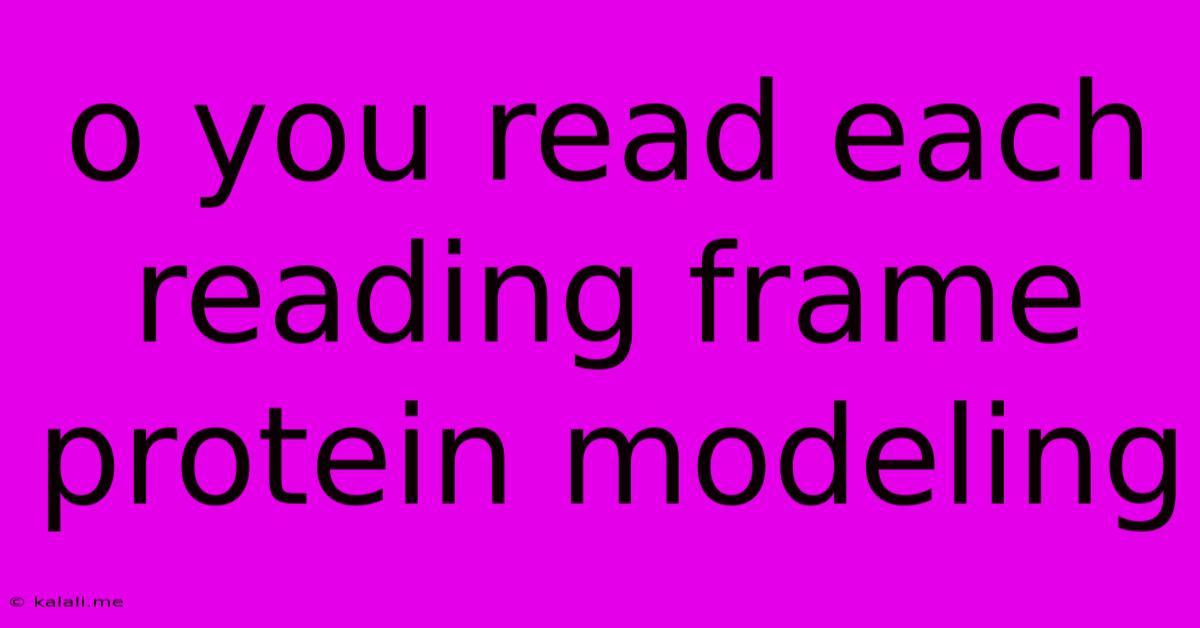O You Read Each Reading Frame Protein Modeling
Kalali
Jun 02, 2025 · 4 min read

Table of Contents
Do You Read Each Reading Frame? Protein Modeling and the Importance of All Six Frames
Protein modeling is a crucial aspect of bioinformatics, allowing scientists to predict the three-dimensional structure of proteins based on their amino acid sequence. This process is vital for understanding protein function, designing new drugs, and advancing our understanding of biological processes. However, a critical, often overlooked, step in this process is the consideration of all six reading frames. This article explores the significance of analyzing each reading frame during protein modeling and the implications of ignoring this essential step.
Meta Description: Understanding protein structure is key in bioinformatics. Learn why analyzing all six reading frames in protein sequence analysis is crucial for accurate protein modeling and avoiding errors in your research.
Understanding Reading Frames
A reading frame refers to one of three possible ways to translate a nucleotide sequence into a protein sequence. Since each codon (a sequence of three nucleotides) codes for a specific amino acid, shifting the reading frame by just one nucleotide can drastically alter the resulting protein sequence. Because DNA is double-stranded, we must consider both strands, leading to a total of six possible reading frames. Ignoring any of these frames could lead to missing potentially important proteins.
Why Consider All Six Reading Frames?
Several reasons highlight the importance of analyzing all six reading frames during protein modeling:
-
Discovery of Overlapping Genes: Some organisms, especially viruses and bacteria, employ overlapping genes. This means that a single DNA sequence can encode multiple proteins, with the coding regions overlapping in different reading frames. Failing to consider all frames would result in missing these additional proteins.
-
Identification of Small Proteins/Peptides: Small proteins or peptides, often crucial for regulatory functions, might be missed if only a single reading frame is considered. These smaller sequences might not be easily detectable using standard prediction methods unless all frames are scanned.
-
Improved Accuracy in Gene Prediction: Accurate gene prediction relies on identifying the correct start and stop codons. Analyzing multiple reading frames increases the chance of identifying the true coding sequence, minimizing false positives and negatives.
-
Enhanced Annotation of Genomes: Complete genome annotation requires the identification of all protein-coding sequences within a genome. Considering all six frames is essential for a comprehensive and accurate annotation.
Practical Implications of Ignoring Reading Frames
Overlooking this crucial step can have several detrimental consequences:
-
Incomplete Protein Models: An incomplete understanding of the proteome can lead to inaccurate biological interpretations and hamper downstream analyses.
-
Misinterpretation of Biological Function: Missing proteins might play vital roles in cellular processes. Ignoring them could lead to inaccurate conclusions about the biological function of a system.
-
Inaccurate Drug Target Identification: Protein modeling is often used in drug discovery to identify potential drug targets. Missing proteins could lead to the identification of inappropriate drug targets or failure to identify promising drug candidates.
-
Erroneous Evolutionary Analyses: Incomplete proteome data can distort phylogenetic analyses and lead to flawed evolutionary inferences.
Tools and Techniques for Analyzing All Six Reading Frames
Several bioinformatics tools and techniques are available to efficiently analyze all six reading frames. These typically involve sophisticated algorithms and statistical methods to identify potential coding sequences within a given DNA sequence. These tools often include features such as:
-
ORF (Open Reading Frame) finders: These tools identify potential protein-coding sequences by searching for start and stop codons in all six reading frames.
-
Hidden Markov Models (HMMs): HMMs are probabilistic models used to predict genes and other biological features based on sequence characteristics.
-
Machine learning algorithms: Various machine learning approaches can be applied to improve the accuracy of gene prediction and ORF identification.
Conclusion
In conclusion, considering all six reading frames during protein modeling is not merely a technical detail but a fundamental requirement for accurate and comprehensive results. Ignoring this step can lead to significant errors and misinterpretations. By employing appropriate bioinformatics tools and techniques, researchers can ensure a thorough analysis of all potential protein-coding sequences, leading to a more complete understanding of biological systems and paving the way for advancements in various fields, including drug discovery and genomics. The extra effort invested in reading each frame ensures a more robust and reliable foundation for all subsequent analysis and interpretation.
Latest Posts
Latest Posts
-
How To Remove Bathroom Floor Tile
Jun 04, 2025
-
What To Choose Domain Or Url Console
Jun 04, 2025
-
Another Way Of Saying About Me
Jun 04, 2025
-
How Often Should A Water Heater Be Flushed
Jun 04, 2025
-
How To Turn Off A Radiator
Jun 04, 2025
Related Post
Thank you for visiting our website which covers about O You Read Each Reading Frame Protein Modeling . We hope the information provided has been useful to you. Feel free to contact us if you have any questions or need further assistance. See you next time and don't miss to bookmark.